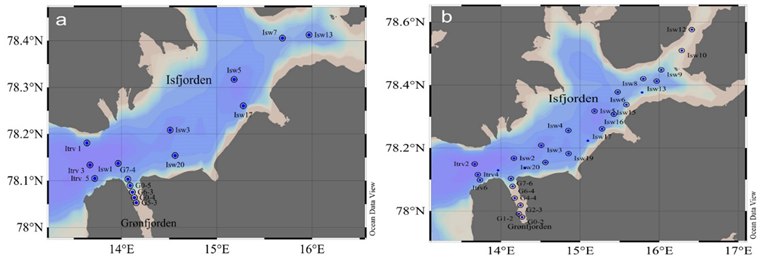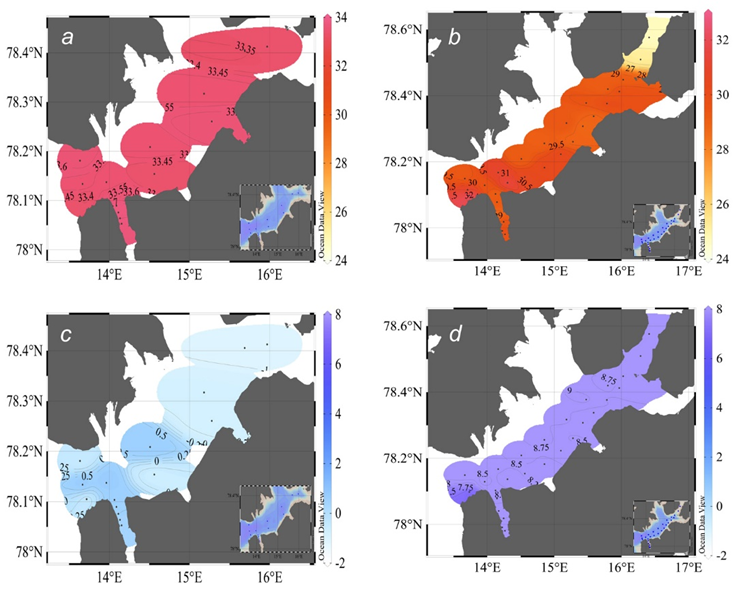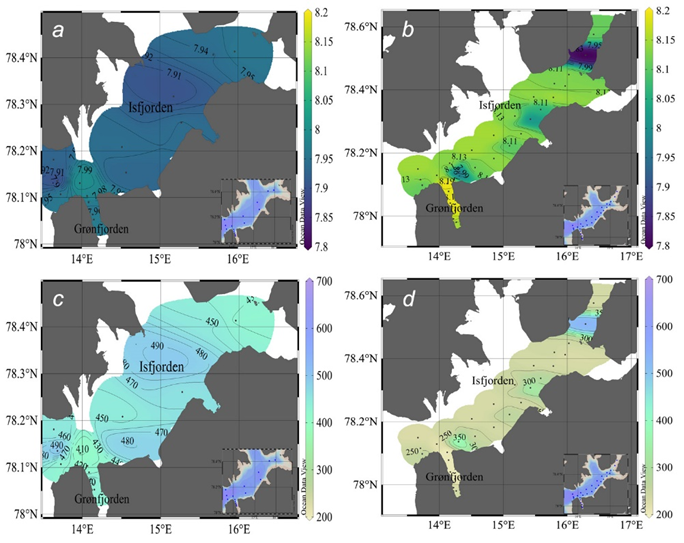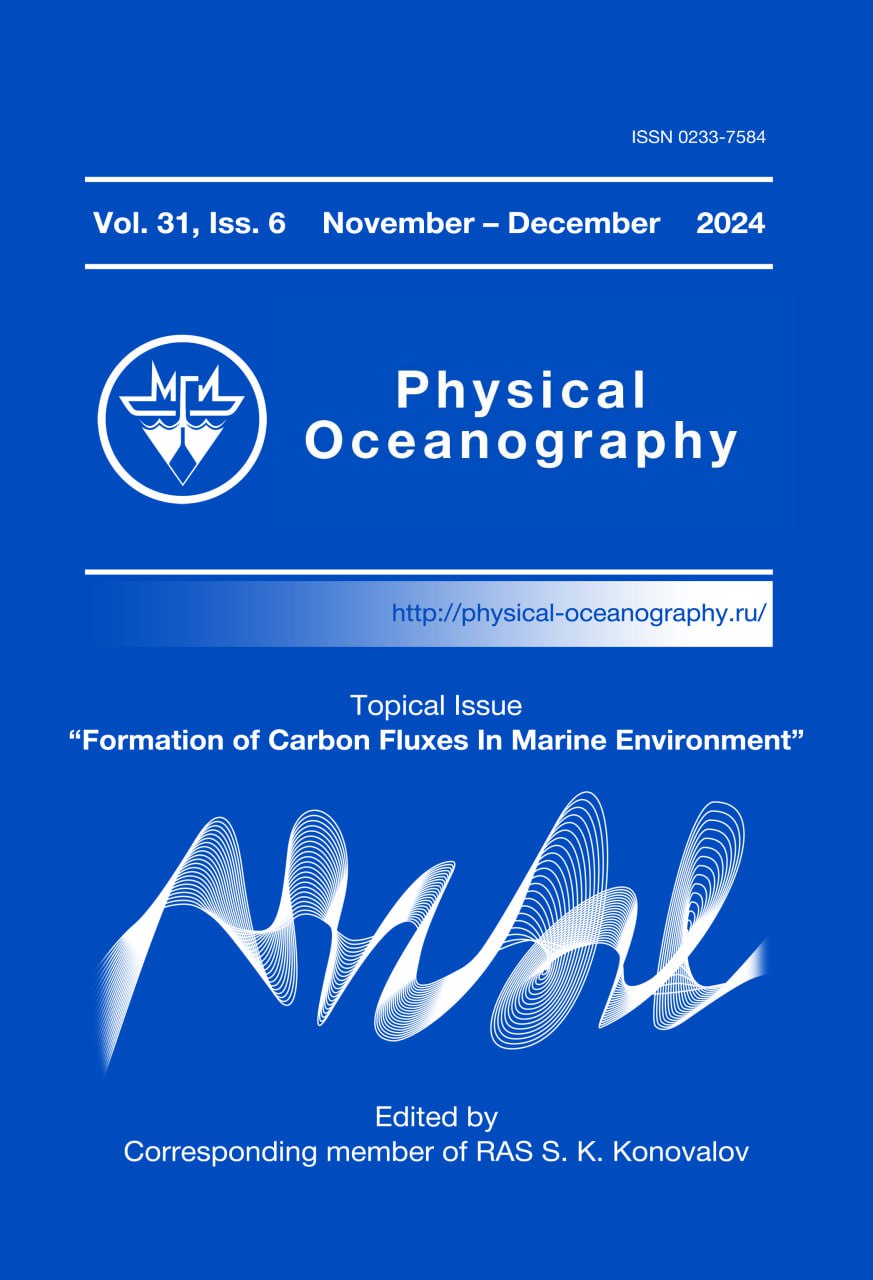Russian Federation
Russian Federation
Russian Federation
Russian Federation
Russian Federation
Russian Federation
Russian Federation
Purpose. The study is purposed at assessing and analyzing spatial variability and seasonal dynamics of the carbonate system parameters in the fjords of Western Spitsbergen based on the results of field research in the spring (April) and summer (August) seasons, 2023. Methods and Results. The physical and chemical parameters of water, such as total alkalinity, pH and nutrient contents were studied. The samples were analyzed in the chemical analytical laboratory of the Russian Scientific Center at Spitsbergen (RSCS). The pH was measured using a Mettler Tolledo Seven Compact S220 laboratory pH-meter, and total alkalinity – by direct titration of a seawater sample with a 0.02 hydrochloric acid (the equivalence point was determined visually). The concentrations of phosphates and silicates, as well as chlorophyll a were measured by standard spectrometric methods. The carbonate system parameters and CO2 flux direction and speed were calculated using the Program Developed for CO2 System Calculations. The revealed seasonal dynamics and variability of the carbonate system parameters are closely related to the atmospheric conditions, water mass seasonal variability and intensity of bioproductivity. The estimates of carbon dioxide flux obtained using the data for August 2023 allow to conclude that during this period CO2 is absorbed in Grønfjorden (–1.52 ... –4.76 mmol m–2·day–1) and Isfjorden (–0.12 ... –1.0 mmol m–2·day–1), whereas in Billefjorden a local area with positively directed CO2 flux (1.2–2.6 mmol m–2·day–1) was discovered. Conclusions. The studies carried out in the fjords have resulted in revealing seasonal fluctuations in the carbonate system parameters and the carbon dioxide fluxes similar to other inner fjords of Spitsbergen. The obtained results highlight the importance of the carbonate system parameters in understanding the biogeochemical balance and the state of marine ecosystems in the context of climate change.
Western Spitsbergen fjords, marine carbonate system, CO2 flux, chlorophyll a, aragonite, Arctic
Introduction
Global change in the climate system of our planet is one of the key problems that has a significant impact on almost all areas of human activity. The polar regions of the Earth and, in particular, the Arctic Ocean are the most important indicators and factors of these changes. In recent decades, the Arctic region has seen a reduction in the ice cover area, an increase in the influence of Atlantic waters, and an intensification of cyclonic activity, which lead to a restructuring of the water column and a change in the intensity of hydrochemical and hydrobiological processes.
The largest changes in the climate system occur in the western Arctic, including the Spitsbergen region. Studies [1] showed that the mean annual surface air temperature in Western Spitsbergen increased by 4 °C in the period 1970–2012, which significantly exceeds the increase in global air temperature (0.7 °C) over the same period. At the same time, the greatest increase in air temperature of 7 °C in winter was recorded in the north of Spitsbergen since 1979 according to the results of the ERA-Interim reanalysis of the European Centre for Medium-Range Weather Forecasts [2].
At the same time, the temperature of the Atlantic water masses in the Western Spitsbergen fjords increased (e.g. by 0.2 °C in the Isfjorden [3]), and more frequent intrusions of Atlantic water into the western fjord systems were recorded [4, p. 5]. A negative trend in glacier mass balance on the archipelago [5] also occurs, contributing to increased glacier meltwater discharge into coastal seas. All these climate changes affect the ongoing biogeochemical processes in the fjords of Western Spitsbergen, especially the marine carbonate system.
The carbonate system regulates the seawater pH and controls the dioxide (CO2) circulation between the biosphere, lithosphere, atmosphere and oceans [6]. Its main parameters are total alkalinity (TA), dissolved inorganic carbon (DIC), pH and partial pressure of CO2 (pCO2) . Knowing these parameters and taking into account wind speed and pCO2 in the atmosphere, we can quantify and determine whether the ocean absorbs carbon dioxide or releases it into the atmosphere.
The Western Spitsbergen fjords are located in the zone of active interaction of warm, salty Atlantic and cold, fresher Arctic waters. The study area included Isfjorden, one of the largest fjords in the Arctic and the second longest in Spitsbergen; Grønfjorden, a relatively small fjord on the south side of Isfjorden, not far from its mouth; and Billefjorden, located in the inner part of Isfjorden. For all fjords, 7 types of water masses are distinguished: surface, intermediate, transformed, Atlantic, Arctic, local and winter [7, p. 129].
In contrast to the well-studied hydrological regime, the studies of features of biogeochemical processes and parameters of carbonate system in the Western Spitsbergen fjords are more fragmentary. Moreover, the small amount of data related to this topic is often limited to individual sections of the fjords, which hinders their broader interpretation [1, 8–10]. Thus, in the Isfjorden system, most of the studies that described seasonal dynamics of such water parameters as pH, TA, dissolved oxygen, DIC, the degree of water saturation with aragonite (ΩAr), etc. [1, 10, 11] were carried out in the small Tempelfjorden and Adventfjorden in 2011–2017. The observations revealed that the glacial impact is reflected in the biogeochemical structure of Tempelfjorden waters both in summer and winter [11]. The results demonstrated a significant influence of coastal runoff and glacial meltwater on the carbonate system and CO2 absorption capacity. An analysis of the data obtained in Adventfjorden showed that the main driver of TA and DIC variability was salinity variations associated with river runoff, mixing processes and advection of water masses: 77 and 45%, respectively. Biological activity provided 60% of the monthly ΩAr variations and salinity changes had virtually no effect (5%) [1]. An analysis of measurements in Tempelfjorden [8] confirmed that an increase in freshwater (terrestrial and glacial) transforms the ocean from a source to a sink of CO2 and provides positive feedback on ocean acidification.
At the same time, there are very few measurements of biogeochemical structure parameters of waters and the carbonate system carried out directly in Isfjorden itself, and all of them relate to the summer period [12, 13]; such measurements for Grønfjorden and Billefjorden are absent.
The aim of this work is to assess the spatial variability and seasonal dynamics of carbonate system parameters in the fjords of Western Spitsbergen, based on the results of expeditions in the spring (April) and summer (August) of 2023. This work will also make an important contribution to the dataset on the marine carbonate system of fjords.
Materials and methods
The studies of biogeochemical processes in the bays of Western Spitsbergen, carried out in April and August 2023, included oceanographic and hydrochemical analysis. Seawater samples were taken at specific horizons. As a result of laboratory analysis of these samples, the characteristics of TA, pH, phosphates, silicate silicon and chlorophyll a concentrations were obtained.
Surface water samples were collected at 15 and 28 oceanographic stations in the bays of Isfjorden and Grønfjorden in spring and summer respectively (Fig. 1). The total number of seawater samples processed was 790.
In April 2023, thermohaline profiling was carried out from the small ship Farm using the SBE-19plusV2 SeaCat CTD probe. The accuracy of conductivity and temperature sensors was 0.0005 Cm·m–1 and 0.005 °C, respectively. In August 2023, thermohaline profiling in the Isfjorden waters was carried out from the boat Barentsburg, and in the Grønfjorden waters – from the boat PolarCirkel 660 Work using the RBRconcerto C.T.Dfast CTD probe. The accuracy of the conductivity and temperature sensors was 0.003 Cm·m–1 and 0.002 °C, respectively.
Seawater sampling was carried out at 0, 5, 10, 25, 50 m horizons using the Ruttner bathometer. Sample analysis was carried out in the analytical laboratory of the RSCS.

F i g. 1. Sampling stations in the fjords of Western Spitsbergen in April (а) and August (b), 2023
The pH was measured on the NBS scale using the Mettler Tolledo Seven Compact S220 laboratory pH meter in accordance with the procedure set out in RD 52.10.735-2010, with a measurement accuracy of ±Δ0.05. Calibration was performed at three points (4.01, 7.0, 9.21) using Mettler Tolledo buffer solutions.
To determine the total alkalinity, a sample was titrated with a hydrochloric acid solution while simultaneously passing a flux of CO2-free air through the titrated sample to the equivalence point. The measurement accuracy was ±Δ0.014 mmol·l–1 in accordance with the RD 52.10.743-2010 technique.
The content of nutrient compounds (silicate silicons, phosphates) was determined by the standard spectrometric method (RD 52.10.744-2020 and RD 52.10.738-2010), with a measurement accuracy of ±Δ0.06.
The chlorophyll a concentrations were obtained by spectrophotometry in accordance with GOST 17.1.4.02-90 standard, with an error of ±Δ20%.
The carbonate system components and the degree of water saturation with aragonite were calculated using the Program Developed for CO2 System Calculations . The dissociation constants for carbonic acid, as outlined in [14], were applied in the calculation of carbonate system parameters.
The direction of carbon dioxide flux in the water – atmosphere system was obtained by Wanninkhof quadratic parameterization from [15] on the basis of the data on pCO2 in water and in the atmosphere, as well as on wind speed. The calculations were based on the data on carbon dioxide content in atmospheric air, measured by a CO12M Environnement S.A. carbon monoxide and dioxide analyzer, and wind speed in the atmosphere surface layer (up to 2 m) measured by a Campbell Scientific meteorological tower.
Results and discussions
In April 2023, a transformed Atlantic water mass with positive temperature values and a salinity of 34.7–34.8 was recorded in the surface layer of the Isfjorden and Grønfjorden waters westward of 14.9°E (Fig. 2). The surface layer of the eastern part of Isfjorden was not affected by Atlantic waters. Instead, a local water mass (temperature below 0 °C, salinity less than 34.7) formed in the autumn – winter period as a result of cooling of the surface and intermediate water masses. Furthermore, the entire area under study was characterized by a homogeneous vertical distribution of temperature and salinity, which is typical for this season.
In August 2023, the surface temperature and salinity values of the fjord waters varied from 6.9–9 °C to 24.7–32.3, respectively. The minimum salinity values were observed in Billefjorden at stations Isw12 (24.7) and Isw10 (25.3). Salinity values at all other stations exceeded 28.8. The lowest temperature value was recorded at station Itrv6. At all other locations, the temperature values exceeded 8 °C. The lower boundary of the surface water mass (T > 1 °C, S < 34.3) in the study area was identified at depths of 30–45 m.

F i g. 2. Distribution of hydrophysical parameters in the surface layer of the Western Spitsbergen fjords, 2023: salinity in April (а) and August (b); temperature in April (c) and August (d)
In April, TA concentrations in Isfjorden varied within the range of 1641–1761 μmol·kg–1, and in Grønfjorden – within 1686–1743 μmol·kg–1 (Fig. 3). In August, TA concentrations in Isfjorden varied within 1610–1820 μmol·kg–1, in Grønfjorden – within 1710–1830 μmol·kg–1 and in Billefjorden within 1520–1570 μmol·kg–1.

F i g. 3. Distribution of total alkalinity (µmol·kg–1) in the surface layer of the Western Spitsbergen fjords in April (a) and August (b), 2023
In April 2023, slight spatial variability in pCO2 in Isfjorden and Grønfjorden surface layers, ranging from 400 to 500 μatm, was recorded. Decreased pH values (7.89–8.00) and increased pCO2 values (Fig. 4) in both fjords in spring 2023 suggest organic matter mineralization in the surface layer.

F i g. 4. Surface distribution of pH in April (а) and August (b), and pCO2 (µatm) in April (c) and August (d) in the Western Spitsbergen fjords, 2023
In August, pH values in the Isfjorden area were within 7.97–8.15. At the same time, pCO2 values in most of the fjord area were ~ 350 μatm, except for the local zones with elevated values of 400–450 μatm. In Grønfjorden, pCO2 varied within 276–330 μatm, and pH within the range of 8.14–8.20.
The highest values of pCO2 (730 μatm) and reduced (to 7.8) pH values were observed in Billefjorden (Fig. 5). This distribution pattern of carbon dioxide and pH partial pressure can be explained by two processes occurring simultaneously – organic matter mineralization and photosynthesis. At high concentrations of nutrients and illumination, the photosynthesis process predominates; this leads to carbon dioxide removal from the water for organic matter synthesis. This increases the pH of the environment and makes the water undersaturated with reference to CO2 and oversaturated with reference to oxygen [16, p. 245].

F i g. 5. Distribution of CO2 flux (mmol·m⁻²day⁻¹) at the water – atmosphere boundary in the surface layer of the Western Spitsbergen fjords, 2023, in April (а) and August (b)
In general, higher pH and ΩAr values were recorded in the fjords under study in August compared to April. We observed undersaturation of waters with aragonite (ΩAr < 1) in April. The ΩAr values in August varied within 1.2–1.75. In Billefjorden, a local area with reduced ΩAr values (0.75) was observed.
In Isfjorden, there was a notable variation in chlorophyll a concentrations between April and August. In April, concentrations ranged from 0.04 to 0.11 μg·L–1, while in August, they ranged from 0.26 μg·L–1 (in the inner part of the fjord) to 0.85–0.9 μg·L–1 (in the offshore area). In April, Grønfjorden was characterized by a uniform distribution of chlorophyll a concentrations (0.21 μg·L–1) in the surface layer. In August, the concentrations were significantly higher, increasing from the innermost part (0.64 μg·L–1) to the fjord’s mouth (2.04 μg·L–1). Such high chlorophyll a concentrations suggest a phytoplankton bloom in Grønfjorden in August.
The higher chlorophyll a concentrations in Grønfjord compared to Isfjord are probably due to the coastal runoff effect, which increases the amount of nutrients required for microalgae vegetation. In turn, the high pH values in Grønfjorden contributed to the phytoplankton productivity, increasing the availability of nutrients [17, p. 58].
The distribution of silicon concentrations in the surface layer of the fjords in April was uniform, varying insignificantly within 9–10 μmol·L–1, with minimum values recorded in the mouth of Isfjorden. In August, higher silicon concentrations (4.5–6 μmol·L–1) were typical for Grønfjorden and Billefjorden compared to Isfjorden (2–4.5 μmol·L–1), which is due to the influence of freshwater runoff. Minimum silicon concentrations were observed along the southern shore of Isfjorden.
In April, phosphate concentrations in the surface layer of the fjords varied within 0.6–0.8 μmol·L–1 at most stations. Higher values (1.4 and 1 μmol·L–1) were recorded at stations Isw3 and Isw7, respectively. In August, phosphate concentrations were 0.09–0.73 μmol·L–1 in Isfjorden, 0.1–0.30 μmol·L–1 in Grønfjorden and 0.26 μmol·L–1 in Billefjorden.
The exchange of CO2 between the ocean and the atmosphere takes place in the presence of a vertical partial pressure gradient (ΔрСО2) between the surface layer of seawater and the surface layer of the atmosphere. If ΔрСО2 > 0, CO2 is released from the ocean into the atmosphere and vice versa; if ΔрСО2 < 0, the flux is considered negative and CO2 is absorbed by the ocean [18, p. 220].
The studies presented in this paper were carried out at low wind speeds
(< 5 m·s–1) in both seasons. In April, the calculated water – atmosphere carbon dioxide fluxes (FCO2) for Isfjorden and Grønfjorden varied between 0.37–4.18 and 0.2–1.43 mmol·m–2·day–1, respectively, indicating the release of carbon dioxide into the atmosphere. The obtained FCO2 estimates based on the data for August 2023 allow to conclude that during this period CO2 was absorbed in Grønfjorden
(–1.52 ... –4.76 mmol·m–2·day–1) and Isfjorden (–0.12 ...
–1.0 mmol·m–2·day–1); in Billefjorden, a local area with a positive FCO2
(1.2–2.6 mmol·m–2·day–1) is observed (Fig. 5).
The data from the field observations in April and August 2023 and the results of their analysis are in good agreement with the results of other researchers. For Isfjorden, as well as for other large fjords of Western Spitsbergen – Krossfjorden, Kongsfjorden, Hornsund Bay – a significant spatial variability of TA was typical, which is related to the complexity of the fjord system with numerous freshwater sources (rivers, melting glaciers), which can have different TA concentrations depending on the biogeochemical processes and the geological structure of the catchment. In addition, water column processes such as calcification, CaCO3 dissolution or brine formation, play an important role in the distribution of TA in coastal areas [12]. For example, in 2012 very low total alkalinity values were observed in Tempelfjorden in April – May (1142 μmol·kg–1) and in September (526 μmol·kg–1), which is associated with the effects of intense glacial runoff [11, p. 16]. Our data show that the minimum total alkalinity values were recorded in Billefjorden in August 2023, where (although the Nordenskiöldbreen marine-terminating glacier has already completely retreated onto land) freshening is still significant enough to reduce the total seawater alkalinity during the maximum ablation period in August.
Our studies indicated that for Isfjorden, as well as for Tempelfjorden [8, 10] and Adventfjorden [1], characteristic processes are a decrease in pCO2 and an increase in ΩAr from winter to summer months. At the same time, the pCO2 values (400–500 μatm) in Isfjorden, according to data for April 2023, were higher than those recorded in Tempelfjorden in mid-March 2012 (370 μatm), according to [8, p. 2423], and in March 2016 (330 μatm), according to [10, p. 8]. The ΩAr values (1.2–1.75) for Isfjorden in August 2023 were lower than in August 2018 (2–2.5), according to [12, p. 4] but coincided with the values obtained in Tempelfjord in August 2016 (1.45) and 2017 (1.48), according to work [10, p. 9].
The rates of carbon dioxide fluxes in the water – atmosphere system, calculated for Isfjorden and Grønfjorden based on the data for August 2023, turned out to be lower compared to the estimates obtained for Tempelfjorden (−11 … −17 mmol·m–2·day–1) for June – early August 2017 [11, p. 5], but close to those obtained in the bays under study in September 2022 (− 0.2 … − 1.9 mmol·m–2·day–1) [19, p. 236].
The narrow ranges of concentrations of the main biogeochemical parameters obtained by us in 2023, and earlier by other researchers, allow us to conclude that such values are typical for the area under study, which is characterized by pronounced seasonal fluctuations.
Conclusion
During the study, we compared the data from two expeditions that took place in Isfjorden, Billefjorden and Grønfjorden (Western Spitsbergen) in April and August 2023. Analysis of the results confirmed the well-studied seasonal variability not only of thermohaline properties but also of several biogeochemical processes in this region. Their seasonal variability was manifested in pronounced fluctuations in the parameters of the carbonate system and carbon dioxide fluxes, indicating the dynamic nature of marine ecosystem response to climate change.
The results of the measurements of silicon and phosphate concentrations showed that April was characterized by an almost uniform spatial distribution of their values. In summer, the ranges in which the concentrations of these nutrient compounds varied increased significantly. High silicon concentrations in Grønfjorden and Billefjorden compared to Isfjorden were due to the influence of freshwater runoff. No patterns were found in the spatial distribution of phosphate concentrations in August.
In spring, an increase in pCO2 levels in the surface water layer and a decrease in pH, indicating the process of mineralization of organic matter, were observed. Such pCO2 levels were due to the prevalence of cold water masses and lower solar activity, which affected the intensity of biogeochemical processes. In summer, the opposite trend was observed: a decrease in pCO2 levels and an increase in pH due to the photosynthetic activity of phytoplankton. The increased bioproductivity for this period of the year is caused by active heating of the surface layer and the influx of freshwater runoff, which contributes to more intensive CO2 consumption, an increase in the oxygen content and alkalinity of the water. The surface water layer was characterized by different degrees of aragonite saturation in different seasons: undersaturation (ΩAr < 1) was observed in April, and a decrease in corrosivity was observed in August. It should be noted that the bays were ice-free in April, which made it possible to estimate the direction and rate of CO2 flux in the water – atmosphere system. According to our calculations, small amounts of FCO2 were released into the surface water layer in April, and CO2 was absorbed from the atmosphere into the water in Isfjorden and Grønfjorden in August. A local area with a positive FCO2 flux was recorded in Billefjorden. According to the data for September 2022, FCO2 was also directed from the atmosphere into the water in Isfjorden and Grønfjorden.
Continued and expanded research in this area will contribute to a better understanding of the seasonal dynamics of processes under ongoing climate change, which will allow us to assess the impact of these global changes on the unique and fragile Arctic ecosystems.
1. Ericson, Y., Chierici, M., Falck, E., Fransson, A.I., Jones, E.M. and Kristiansen, S., 2019. Seasonal Dynamics of the Marine CO2 System in Adventfjorden, a West Spitsbergen Fjord. Polar Research, 38, 3345. https://doi.org/10.33265/polar.v38.3345
2. Onarheim, I.H., Smedsrud, L.H., Ingvaldsen, R.B. and Nilsen, F., 2014. Loss of Sea Ice during Winter North of Svalbard. Tellus A: Dynamic Meteorology and Oceanography, 66(1), 23933. https://doi.org/10.3402/tellusa.v66.23933
3. Pavlov, A.K., Tverberg, V., Ivanov, B.V., Nilsen, F., Falk-Petersen, S. and Granskog, M.A., 2013. Warming of Atlantic Water in Two West Spitsbergen Fjords over the Last Century (1912–2009). Polar Research, 32, 11206. https://doi.org/10.3402/polar.v32i0.11206
4. Bloshkina, E.V., Pavlov, A.K. and Filchuk, K., 2021. Warming of Atlantic Water in Three West Spitsbergen Fjords: Recent Patterns and Century-Long Trends. Polar Research, 40, 5392. https://doi.org/10.33265/polar.v40.5392
5. Van Pelt, W., Pohjola, V., Pettersson, R., Marchenko, S., Kohler, J., Luks, B., Hagen, J.O., Schuler, T.V., Dunse, T. [et al.], 2019. A Long-Term Dataset of Climatic Mass Balance, Snow Conditions, and Runoff in Svalbard (1957–2018). The Cryosphere, 13(9), pp. 2259-2280. https://doi.org/10.5194/tc-13-2259-2019
6. Millero, F.J., 2000. The Carbonate System in Marine Environments. In: A. Gianguzza, E. Pelizzetti and S. Sammartano, eds., 2000. Chemical Processes in Marine Environments. Berlin: Springer, pp. 9-41. https://doi.org/10.1007/978-3-662-04207-6_2
7. Bloshkina, E.V. and Filchuk, K.V., 2018. The Present Water Masses Conditions of West Spitsbergen Fjords. Arctic and Antarctic Research, 64(2), pp. 125-140. https://doi.org/10.30758/0555-2648-2018-64-2-125-140
8. Fransson, A., Chierici, M., Nomura, D., Granskog, M.A., Kristiansen, S., Martma, T. and Nehrke, G., 2015. Effect of Glacial Drainage Water on the CO2 System and Ocean Acidification State in an Arctic Tidewater-Glacier Fjord during Two Contrasting Years. Journal of Geophysical Research: Oceans, 120(4), pp. 2413-2429. https://doi.org/10.1002/2014jc010320
9. Fransson, A., Chierici, M., Hop, H., Findlay, H.S., Kristiansen, S. and Wold, A., 2016. Late Winter-to-Summer Change in Ocean Acidification State in Kongsfjorden, with Implications for Calcifying Organisms. Polar Biology, 39, pp. 1841-1857. https://doi.org/10.1007/s00300-016-1955-5
10. Ericson, Y., Falck, E., Chierici, M., Fransson, A. and Kristiansen, S., 2019. Marine CO2 System Variability in a High Arctic Tidewater-Glacier Fjord System, Tempelfjorden, Svalbard. Continental Shelf Research, 181, pp. 1-13. https://doi.org/10.1016/j.csr.2019.04.013
11. Pogojeva, M., Polukhin, A., Makkaveev, P., Staalstrøm, A., Berezina, A. and Yakushev, E., 2022. Arctic Inshore Biogeochemical Regime Influenced by Coastal Runoff and Glacial Melting (Case Study for the Templefjord, Spitsbergen). Geosciences, 12(1), 44. https://doi.org/10.3390/geosciences12010044
12. Koziorowska-Makuch, K., Szymczycha, B., Thomas, H. and Kuliński, K., 2023. The Marine Carbonate System Variability in High Meltwater Season (Spitsbergen Fjords, Svalbard). Progress in Oceanography, 211, 102977. https://doi.org/10.1016/j.pocean.2023.102977
13. Saghravani, S.R., Böttcher, M.E., Hong, W.-L., Kuliński, K., Lepland, A., Sen, A. and Szymczycha, B., 2024. Distributions of In-Situ Parameters, Dissolved (In)Organic Carbon, and Nutrients in the Water Column and Pore Waters of Arctic Fjords (Western Spitsbergen) during a Melting Season. Earth System Science Data, 16, pp. 3419-3431. https://doi.org/10.5194/essd-16-3419-2024
14. Mehrbach, C., Culberson, C.H., Hawley, J.E. and Pytkowicx, R.M., 1973. Measurement of the Apparent Dissociation Constants of Carbonic Acid in Seawater at Atmospheric Pressure. Limnology and Oceanography, 18(6), pp. 897-907. https://doi.org/10.4319/lo.1973.18.6.0897
15. Wanninkhof, R., 2014. Relationship between Wind Speed and Gas Exchange over the Ocean Revisited. Limnology and Oceanography: Methods, 12(6), pp. 351-362. https://doi.org/10.4319/lom.2014.12.351
16. Tishchenko, P.Ya., Tishchenko, P.P., Zvalinsky, V.I., Shkirnikova, E.M., Chichkin, R.V. and Lobanov, V.B., 2006. Carbonate System of the Amur Bay (Japan Sea) in Summer 2005. Izvestiya TINRO, 146, pp. 235-255 (in Russian).
17. Berezovskaya, V.A. and Lyandsberg, R.A., 2004. [Factors Affecting the pH Value in Coastal Waters of Kamchatka]. Bulletin of Kamchatka State Technical University, 3, pp. 58-61 (in Russian).
18. Malinin, V.N. and Obraztsova, A.A., 2011. [Variability of the Exchange of Carbon Dioxide in the System Ocean-Atmosphere]. Society. Environment. Development = Terra Humana, (4), pp. 220-226 (in Russian).
19. Alekseeva, N.K., Nikulina, A.L., Ryzhov, I.V., Novikhin, A.E., Kornilova, R.V., Smirnov, N.A. and Fedorova, A.A., 2023. Marine Carbonate System Parameters of the West Spitsbergen Fjords in Late Summer 2022. In: T. Chaplina, ed., 2023. Complex Investigation of the World Ocean (CIWO-2023). CIWO-2023. Springer Proceedings in Earth and Environmental Sciences. Cham: Springer, pp. 233-238. https://doi.org/10.1007/978-3-031-47851-2_27














